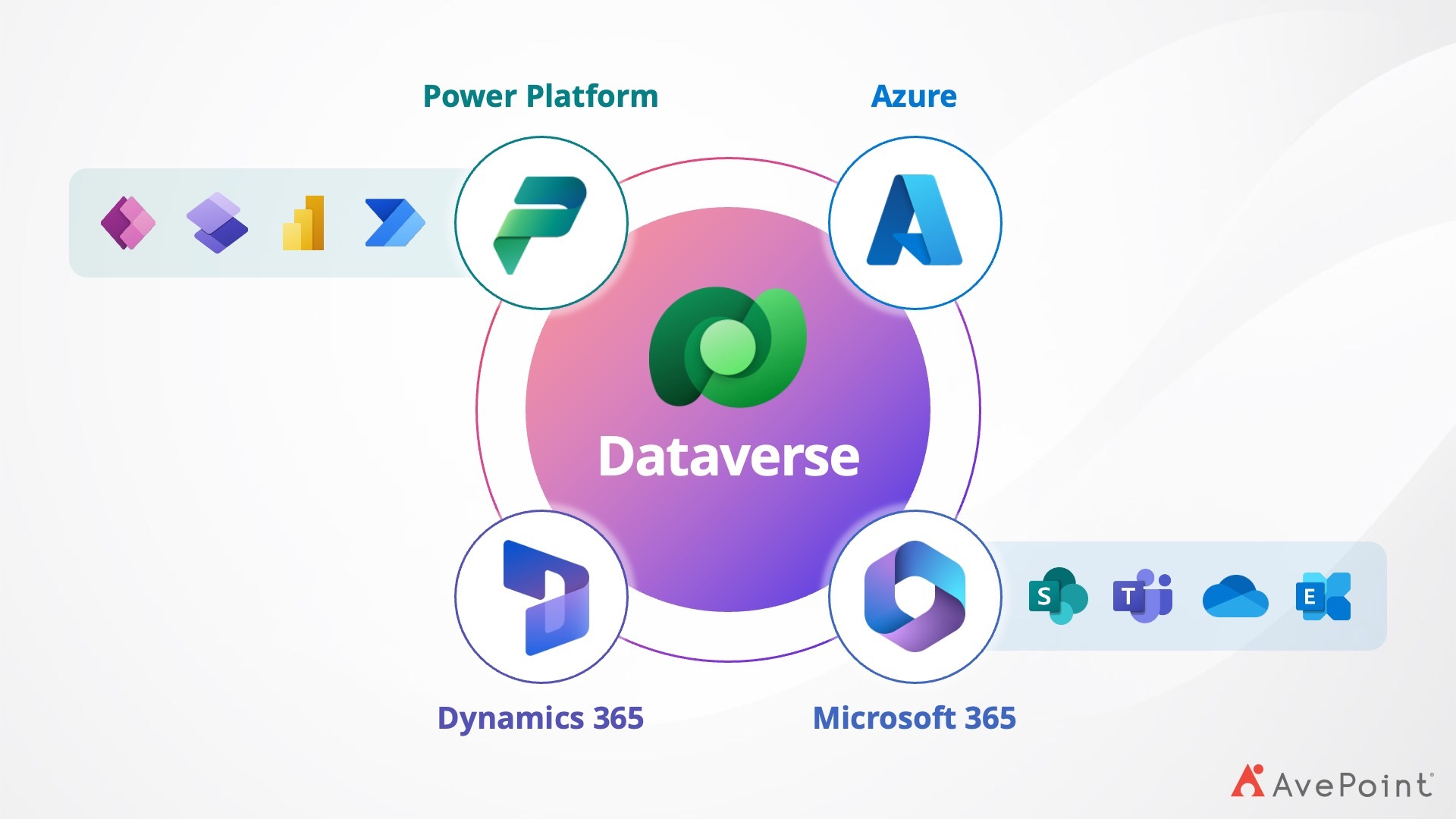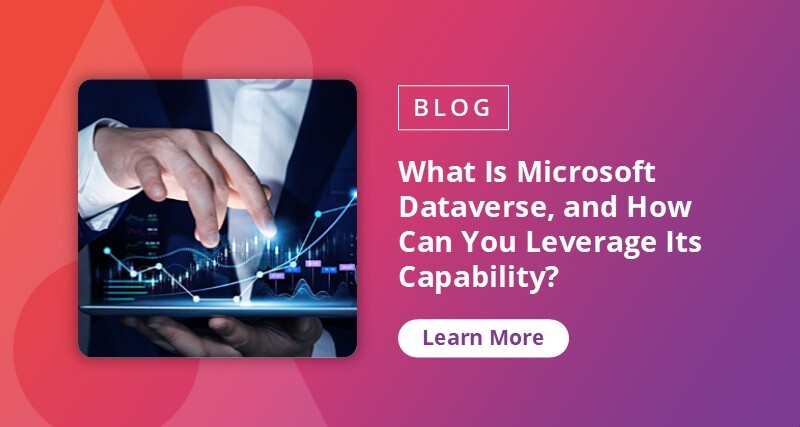In our previous blog, we unpacked what Microsoft Dataverse is and how organisations can leverage its powerful capabilities across the Microsoft ecosystem. As Dataverse becomes more embedded in business-critical operations, protecting it is no longer optional but essential. From ensuring data security and compliance to enabling seamless operations and real-time insights, robust Dataverse protection underpins business continuity. Yet many organisations still overlook this crucial layer.
This blog explores why securing Dataverse is vital and how it supports resilient, scalable growth. The visual below demonstrates how it all connects:
The Importance of Protecting Dataverse
Dataverse is more than just a collection of tables — it’s a robust data platform that integrates deeply with Microsoft 365 and its services, including Azure, Dynamics 365, and the Power Platform.
Power Platform
The Power Platform leverages Dataverse as its core for data storage and management, enabling the creation of custom applications to efficiently retrieve and manipulate specific datasets. According to Forrester’s 2024 report, The Total Economic Impact™ of Microsoft Power Apps, organisations using Power Apps have seen app development time cut down by 50%, allowing professional developers to redirect their efforts away from building internal workflow apps and toward more strategic initiatives. This translates to substantial time savings and improves operational efficiency.
However, this efficiency comes with risks, particularly that of application downtime. With 80% of companies experiencing cloud security incidents in 2024, cloud security remains a critical concern. IBM’s 2024 Cost of a Data Breach Report further underscores this vulnerability, revealing that 82% of breaches involved cloud-stored data. While cloud environments offer flexibility and scalability, they also introduce significant exposure to potential threats, the impacts of which can be severe for organisations.
Take, for example, a retail company using a custom Power App connected to Dataverse to manage inventory across multiple stores in Australia and New Zealand. If the Power App fails and there is no backup in place, the company could lose all inventory data — leading to operational disruption, financial losses, and a major setback in business operations and continuity. This highlights the necessity of a resilience strategy.
Dynamics 365
Core Dynamics 365 applications, such as Customer Service and Sales, depend heavily on Dataverse to store critical business data, such as customer data, sales records, and service histories.
Consider yourself an organisation that relies on Dynamics 365 Customer Service integrated with Microsoft Dataverse to manage customer support cases. Imagine coming in on Monday morning and all open cases have disappeared, caused by a misconfiguration. There is no backup available; therefore, the team can’t see any case histories, causing customer frustration by having to repeat issues, breached service-level agreements, and accurate metrics cannot be provided to the executive.
Dataverse protection is essential, as such a loss would have a severe impact. It could harm customer relationships, disrupt revenue generation, and damage trust in the business’ ability to manage and safeguard sensitive data.
Microsoft 365
While Microsoft 365 services like SharePoint and Teams are not directly built on Dataverse, they often integrate with Power Platform solutions that utilise it. This makes Dataverse protection crucial for maintaining the seamless operations of these services. If Dataverse becomes unavailable, it can disrupt these integrations — leading to workflow interruptions, productivity losses, and communication breakdowns.
Consider a scenario where Microsoft 365 is your primary collaboration tool, which uses Dataverse as the backend for organisational information such as employee roles, departments, and reporting structures. Microsoft 365 accesses Dataverse data to automatically tag metadata in SharePoint and dynamically manage memberships in Teams. A misconfigured security role can result in the deletion of employee metadata, causing a ripple effect across the organisation, such as SharePoint libraries being unable to classify or filter documents by department or role, failure to validate access permissions based on organisational structure, and inability to establish dynamic team memberships in Microsoft Teams.
The impact of this would make it difficult for users to find the right information and potentially expose sensitive information.

Azure
Dataverse integrates seamlessly with a range of Azure services – including Microsoft Entra ID, Azure Logic Apps, Azure Monitor, and Application Insights – forming a powerful, centralised data management foundation.
When paired with Entra ID, Dataverse enables streamlined identity management through features like a unified employee directory, role-based access control (RBAC), and dynamic group assignments based on department, job title, or project attributes. These groups then govern access to Azure resources like virtual machines, databases, and storage accounts.
This integration is key to why Microsoft Entra ID has seen widespread enterprise adoption. According to Gartner Peer Insights, organisations across industries – including finance, healthcare, and education –describe Entra ID as a one-stop shop for identity governance, administration, and security. Its deep integration with the Dataverse makes it a cornerstone of modern identity and access management strategies.
However, this tight coupling also introduces risk. Imagine your organisation has integrated Microsoft Entra ID to manage RBAC. A synchronisation issue between Dataverse and Entra ID results in outdated identity data being synced, unintentionally removing users from security groups, revoking their access to critical resources, and granting excessive permissions to others.
The impact of this leads to security vulnerabilities with overexposed content, and automated deployment pipelines could fail, halting infrastructure provisioning, while reporting and analytics tools may deliver inaccurate insights, leading to operational inefficiencies.
Third-Party Solutions
Due to the nature of Dataverse, Dataverse integrates with third-party solutions to leverage data management capabilities and plays an essential role in supporting the organisation’s operational efficiency.
For example, a third-party CRM system such as Salesforce relies on Dataverse to store critical backend data such as product inventory, shipment statuses, and customer service records. The two systems are integrated to ensure Salesforce users have real-time visibility into product availability and order fulfillment. An integration issue, caused by a misconfigured API connector, leads to a breakdown in data synchronisation between Dataverse and Salesforce.
The business operations are affected as sales representatives cannot see updated inventory levels or shipping delays in Salesforce, leading them to overpromise delivery timelines to customers. This disconnect not only frustrates customers but also causes internal inefficiencies and missed sales opportunities.
This demonstrates how even a temporary integration issue with Dataverse can significantly disrupt Salesforce’s ability to provide accurate, timely, and coordinated customer engagement.
The Importance of Data Resilience
In the 2024 Uptime Institute data center survey, 53% of organisations said they experienced an outage in the past three years and more than half (54%) of the serious outages cost more than $100,000, with 25% costing more than $1 million.
What would be the impact on your organisation if your systems were down for 25 hours, or what would the financial impact be if you experienced a data breach?
Today, data resilience is more than just a buzzword — it refers to the ability of a system to withstand and recover from disruptions, ensuring critical data remains intact and accessible. This capability is crucial because it minimises downtime, prevents data loss, and provides business operations can continue smoothly despite unexpected events such as cyberattacks, overwriting data, accidental deletion, data corruption, or system failures. Ensuring a robust data resilience program, enhances compliance with regulatory standards and builds trust and reliability by ensuring that data is secure and consistently available.
The Risks of Relying Solely on Native Backup
Microsoft Dataverse isn't merely a data storage solution; it's a scalable, enterprise-grade platform designed to ensure the integrity, accessibility, and security of your data. While native Microsoft tools provide some backup capabilities, they fall short of delivering a truly resilient data protection strategy.
One of the primary constraints of native Microsoft Dataverse protection is the limited retention period — deleted data is only recoverable for up to 28 days from the Recycle Bin, after which it is permanently lost. Additionally, Dataverse does not support granular restores, meaning you must restore an entire environment even if only a single record or field is affected. Backups are typically performed once daily, which may not meet strict recovery point objectives (RPO), and there is no support for real-time or continuous backup. Furthermore, not all data changes are tracked, and versioning is limited, making it difficult to audit or roll back unintended modifications. Since backups are stored within the same Microsoft infrastructure, there is a potential single point of failure. Lastly, there are no native alerts or monitoring features to notify users of backup failures or data loss risks.
These limitations highlight the need for third-party solutions to ensure comprehensive, scalable, and resilient data protection, which is recommended by Microsoft themselves:
We recommend that you regularly back up your content and data that you store using third-party apps and services.
How AvePoint Provides Data Resilience for Dataverse
Are you unsure if customer records, applications, tables, entities, apps, reports, and more are protected and recoverable? You can trust AvePoint to ensure that every record, table, and app is fully protected.
AvePoint provides a purpose-built, enterprise-grade solution that addresses the critical gaps in the native Microsoft protection. With AvePoint’s App Aware SaaS Data Protection, organisations can recover exactly what they need – whether it’s an entire table, app or flow, and a single entity, record, or row – enabling fast, targeted recovery without disrupting the environment. Built-in data comparison tools make identifying changes in data, settings, or configurations easy and roll back with confidence.
From a security and scalability standpoint, the AvePoint Confidence Platform is secure, resilient, and isolated from your primary network, storing data in immutable, logically air-gapped copies with customisable retention on your terms. It meets rigorous international compliance standards, including ISO 27001:2013, ISO 27017:2015, ISO 27701:2019, and SOC2 Type II. It holds the highest security standard with the assessment of IRAP to a PROTECTED level, supporting organisations in meeting Essential 8 Maturity Level 3.
AvePoint eliminates the complexity and unpredictability of native protection, with four automated backups per day, granular recovery, and a simple pricing model without surprise fees or storage and retention limits. Regular updates, ongoing innovation, and 24/7 expert support ensure your Dataverse data remains protected, recoverable, and future ready so your operations stay smooth and uninterrupted, no matter the hour.
The Bottom Line
Protecting your data isn’t a nice-to-have — it's a must-have. Dataverse protection is your safety net, ensuring you can keep running smoothly no matter what comes your way. Imagine losing critical customer records or having your applications go offline; the impact on your operations could be devastating.
By implementing robust Dataverse protection, you’re not just protecting data — you're securing the future of your organisation. AvePoint can help you avoid the pitfalls of data loss, keeping your operations seamless and your customers happy. So, take that crucial step to protect your data and ensure business continuity. Your future self will thank you!


